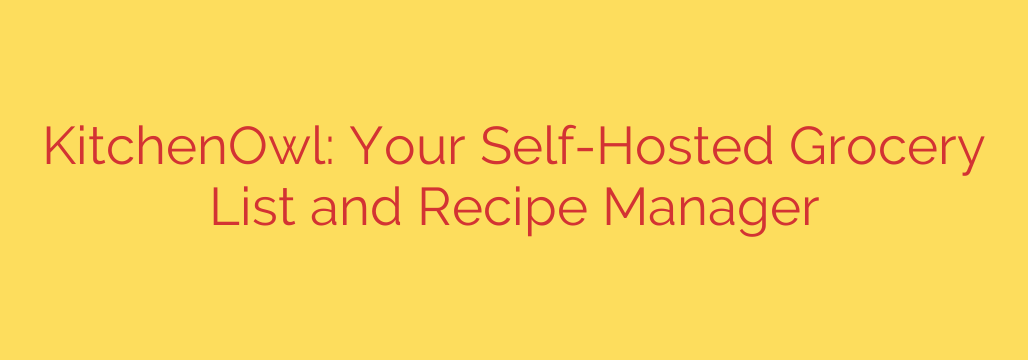
Transform Your Kitchen with a Self-Hosted Recipe and Grocery Manager
In today’s digital world, managing household tasks like meal planning and grocery shopping can feel chaotic. You might have recipes saved as bookmarks, scribbled on notepads, or scattered across different apps. Your shopping list could be a text message to yourself or a piece of paper you forgot on the counter. This disorganization leads to forgotten ingredients, impulse buys, and the dreaded daily question: “What’s for dinner?”
What if you could centralize your entire culinary life into a single, powerful platform that you control? A self-hosted kitchen management system offers a robust solution for home cooks who value organization, efficiency, and data privacy. By running the software on your own server, you can build a permanent, personalized digital cookbook and shopping assistant, free from subscription fees and prying eyes.
Key Features for Ultimate Kitchen Organization
A comprehensive kitchen management platform can revolutionize the way you cook and shop. It combines several essential tools into one seamless interface, making meal preparation simpler and more enjoyable.
Here are the core features that make such a system indispensable:
Advanced Recipe Management: Go beyond simple text files. A proper recipe manager allows you to import recipes directly from websites with a single click, automatically parsing ingredients and instructions. You can also add your own family recipes, complete with photos, notes, and nutritional information. Tagging and categorizing recipes (e.g., “quick dinner,” “vegetarian,” “baking”) makes finding the perfect meal effortless.
Intelligent Grocery Lists: This is where the magic happens. When you decide what to cook, the system can automatically add all the necessary ingredients to your shopping list. Lists can be organized by store aisle or category to streamline your shopping trip. Best of all, these lists are often shareable with family members in real-time, so anyone can add items or check them off as they shop.
Pantry and Inventory Tracking: Reduce food waste and save money by keeping a digital record of what you already have. Before you shop, you can check your virtual pantry to avoid buying duplicate items. Some systems even allow you to track expiration dates, ensuring you use ingredients while they’re still fresh.
Integrated Meal Planning: A drag-and-drop meal planning calendar is a game-changer. Simply drag your saved recipes onto the days you plan to cook them. This not only organizes your week but also powers your grocery list, ensuring you buy exactly what you need for your planned meals.
Cross-Platform Access: A quality self-hosted solution isn’t confined to your computer. It should offer a clean web interface accessible from any browser, as well as dedicated mobile apps for both iOS and Android. This means you can manage recipes at your desk, build a grocery list on your tablet, and check it off at the store on your phone.
Why Choose a Self-Hosted Approach?
While many cloud-based recipe apps exist, the self-hosted route offers distinct advantages, especially for those concerned with privacy and long-term control.
Absolute Data Privacy: When you self-host, your data lives on your hardware. Your recipes, shopping habits, and meal plans are never analyzed, sold, or shared with third parties. You are in complete control of your personal information.
No Subscription Fees: Commercial recipe and grocery apps often rely on recurring monthly or annual fees. An open-source, self-hosted platform is free to use forever. Your only investment is the hardware you already own.
Longevity and Customization: A cloud service can shut down, change its features, or be acquired, leaving you without access to your recipes. A self-hosted application is yours to keep. It will never disappear or remove a feature you rely on. As it’s often open-source, you or the community can even customize it to fit your exact needs.
Getting Started and Actionable Security Tips
Setting up a personal kitchen server is more accessible than ever, primarily through technologies like Docker. Docker simplifies the installation process by bundling the application and its dependencies into a single, easy-to-run container. This eliminates complex setup procedures, allowing you to get a powerful system running in minutes.
If you decide to host your own kitchen manager, prioritizing security is crucial. Here are a few essential tips:
- Use a Reverse Proxy: A reverse proxy like Nginx Proxy Manager or Traefik makes it easy to securely access your application from outside your home network. It can also handle obtaining and renewing free SSL certificates, which encrypt traffic between you and your server.
- Enforce Strong Authentication: Always protect your instance with a strong, unique password. If the application supports two-factor authentication (2FA), enable it for an extra layer of security.
- Perform Regular Backups: Your data is your responsibility. Implement an automated backup strategy to protect your recipes and lists in case of hardware failure or data corruption.
- Keep Software Updated: The developers of open-source software regularly release updates that include new features and important security patches. Periodically check for new versions and update your instance to stay protected.
By taking control of your kitchen data, you can create a more organized, efficient, and private culinary workflow that will serve you and your family for years to come.
Source: https://www.linuxlinks.com/kitchenowl-self-hosted-grocery-list-recipe-manager/








